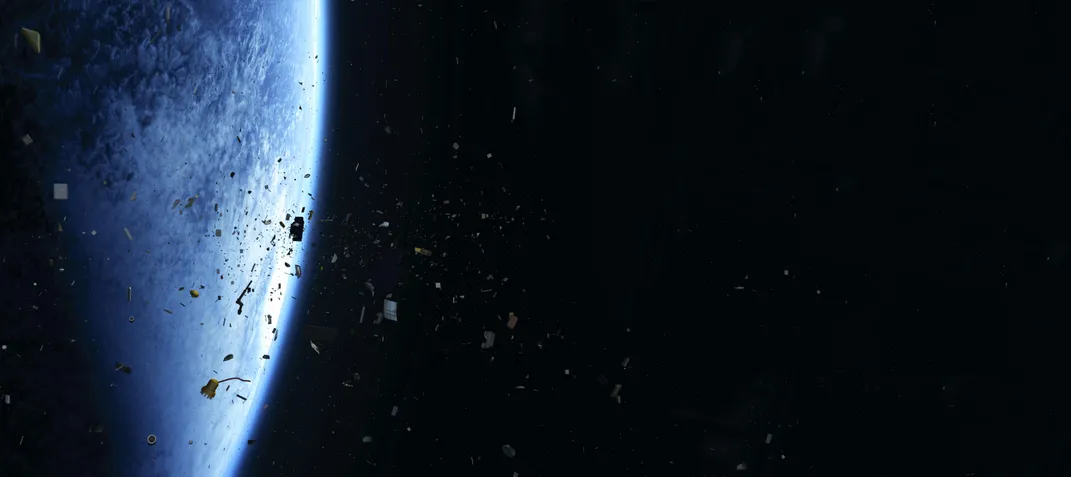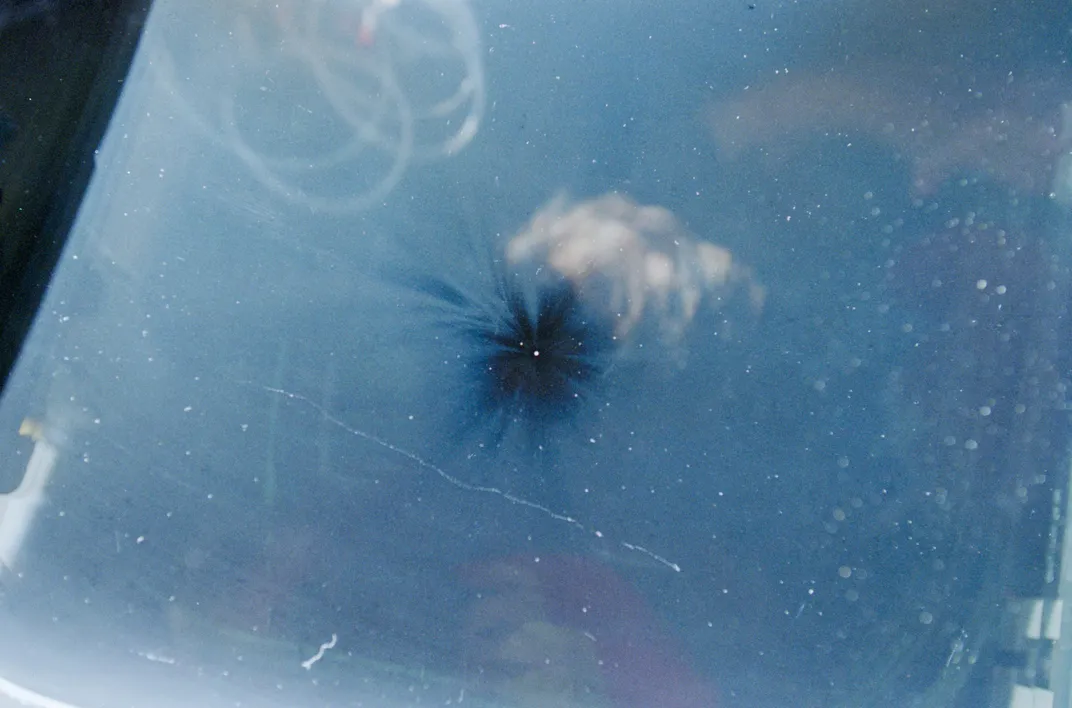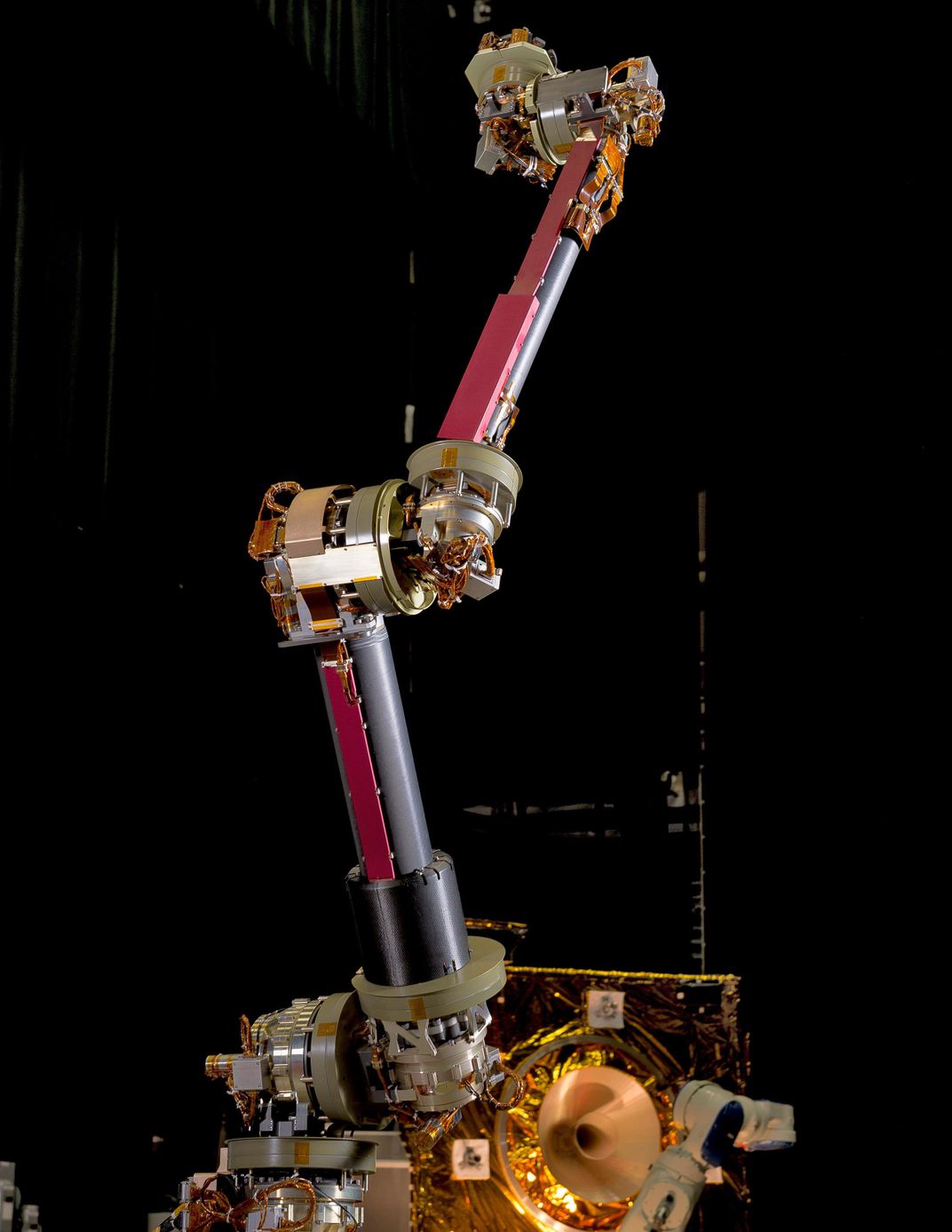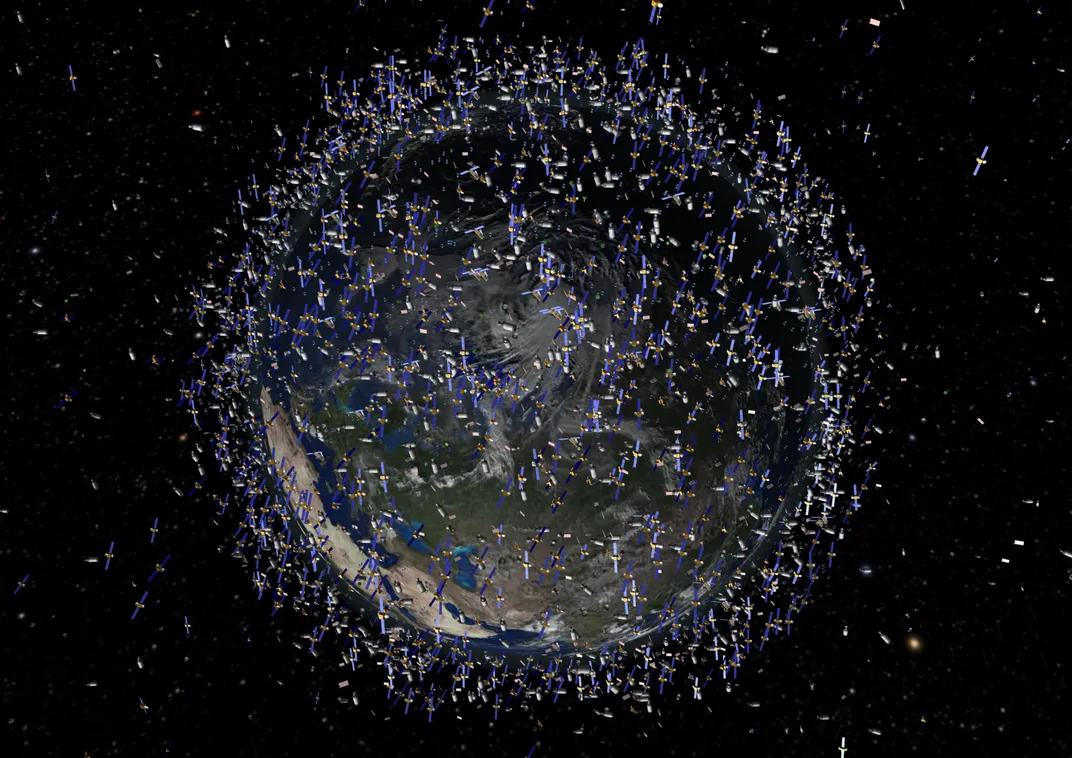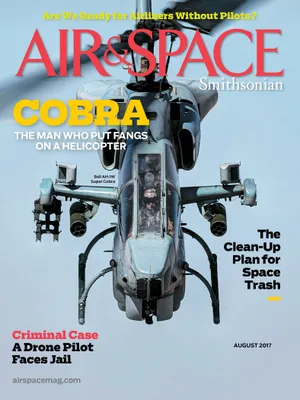Earth, Clean Up Your Trash!
Everyone talks about the orbital debris problem. Europe’s Clean Space program intends to do something about it.
:focal(1499x571:1500x572)/https://tf-cmsv2-smithsonianmag-media.s3.amazonaws.com/filer/20/18/201868f6-4bb9-4641-854e-672505ddee4c/34h_aug2017_32417408375_bd1462e9e1_o_live.jpg)
Think of space junk like cars in a NASCAR race. One vehicle swerves out of control and smacks into another, skidding it into a third car to start a spectacular chain of collisions that leaves wreckage all over the track and ruins the afternoon for half a dozen drivers.
Now suppose the cars are circling hundreds of miles above Earth, and traveling at 17,500 mph. When the first car bumps into the second, both of them rebound into others. Since there is no gravity, nothing slows down, nothing comes to a stop, nothing falls to the ground. A flying piece of fender or a hubcap keeps going until it slams into something else, creating another barrage of shrapnel.
This phenomenon has a name: the Kessler Syndrome, after former NASA scientist Donald J. Kessler, who in 1978 predicted that space would eventually be so congested with dead satellites, pieces of satellites, derelict rocket stages, exploded fuel tanks, detached solar arrays, and other bits of space detritus that low Earth orbit, which in our technology-dependent age is prime real estate, would become unusable.
According to the European Space Agency, this cascade of collisions has already begun. Even if we stopped launching satellites today, it would continue, says Benjamin Bastida, an ESA space debris expert in Darmstadt, Germany. And if space users do nothing to clean up what’s already there, he says, the 29,000 or so large bits of space junk orbiting Earth today “would become more than 200,000 in 200 years.”
Today the U.S. defense department’s Space Surveillance Network tracks only the big pieces—larger than a few inches in diameter. Altogether, there’s about 7,500 tons of stuff in orbit, everything from fragments (the majority of objects) to multi-ton whole satellites. Only seven percent of the total mass is operational satellites. ESA estimates there are 750,000 bits of debris between marble-size and baseball-size, and 166 million smaller particles still capable of doing damage (even tiny flecks of paint moving at five miles per second have scarred spacecraft windshields). The BB-size to marble-size pieces may figure in as many as 100 collisions a year, many of which go unnoticed because they’re more like fender-benders than head-on crashes, or because they hit non-working satellites. Last year Europe’s still-operational Sentinel-1A radar satellite was hit by just such an object, momentarily knocking the spacecraft off kilter and leaving a dent, 15 inches in diameter, in a solar array. It took some figuring by ESA engineers, including studying views from onboard cameras, to reconstruct what had happened.
If space agencies don’t address the debris problem, in time the Space Age could become a new Dark Age. No more satellite phone calls, Internet, or Skype. Even GPS satellites are at risk. Though their orbits are 12,550 miles above Earth, where the debris field isn’t as dense, anything bad that happens up there is forever.
ESA has decided to take action. In 2024, as part of its Clean Space initiative, the agency plans to launch e.deorbit, a $400 million robot spacecraft that will chase down an eight-ton, derelict Earth-observation satellite tumbling in polar orbit 480 miles above Earth. During its approach the spacecraft will carefully synchronize its movements with those of its restless, or “uncooperative,” target. Then it will use a robotic arm to snag a metal ring on its back end, or, perhaps, capture the satellite with a net. Finally, over a period of one or two days, the spacecraft will stabilize the derelict, then use a series of thruster burns to lower it into Earth’s atmosphere, steering it carefully so that even after most of it has burned up, the remaining pieces fall harmlessly into the ocean.
This will be as hard as anything yet attempted in space. Catching up with and capturing a massive, tumbling object, then holding it motionless and disposing of it in a precise, controlled way all pose daunting technical challenges.
There are also economic and political hurdles. The project will be expensive, and deorbiting space junk has no glamorous scientific payoff. ESA project leaders originally planned to capture a small satellite to demonstrate the technology, but decided against proposing such a mission to member nations because of doubts it would get funded. The 2024 mission would be both the demo and the real thing, and ESA won’t even make a final decision on whether to proceed until 2019.
Space cleanup also involves diplomatic and legal sensitivities. A spacecraft built to remove junk could also capture and destroy enemy spysats. What better way to disguise your true intentions than to claim to be cleaning up orbital debris? Although nations with space programs generally agree that space junk must be dealt with eventually, it’s a problem spacefaring nations have been kicking down the road for 40 years. It can be kicked again.
NASA is as worried about the threat as ESA is, but U.S. plans for active debris removal are currently tied to other planned projects, such as Restore-L, a robotic mission to refuel an Earth observation satellite in orbit, which is having its own political difficulties (the White House wants to merge it with similar military and commercial efforts). The idea here is that technologies developed for refueling satellites—robot arms, grapple tools, and software—could also be eventually applied to cleanup.
ESA’s Clean Space initiative, by contrast, addresses the debris problem single-mindedly. And the consensus reached by international scientists and engineers on how to fix it is to remove the big, multi-ton objects first: Reducing the total mass and surface area of potential targets as quickly as possible would forestall a catastrophic chain reaction.
“We’ve been thinking about pulling something out of space for a long time,” says Kessler, retired but still consulting for NASA. “Nobody has ever done it, and if ESA pulls it off they will be the first.”
Working at the Johnson Space Center in the mid-1970s, Kessler began to think about space junk “as a matter of curiosity,” a sideline to his job modeling the early history of the asteroid belt, which formed from a series of collisions that took place over billions of years. He began wondering: What about the man-made stuff?
In building his initial space debris models, Kessler learned that aside from collisions producing fragments, leftover fuel and overcharged batteries together could make nearly empty upper stages of U.S. Delta rockets explode, creating clouds of shrapnel.
Delta program managers at NASA found a way to prevent future explosions by making sure the rockets burned their fuel to depletion, but the damage had already been done, and even today, derelict rocket stages, both U.S. and foreign—some of them launched 40 years ago—are “ticking bombs,” says Holger Krag, chief of the ESA Space Debris Office. Of the 240 junk-producing events monitored over the years, only four cases have involved collisions, with the rest resulting from explosions. But, says Krag, “we expect the ratio to flip as the years go by.”
Kessler’s early research and identification of explosions as a producer of space junk led NASA in 1979 to establish its Orbital Debris Program Office in Houston, with him as senior scientist. Over the next two decades, NASA, ESA, and other space agencies adopted consensus guidelines for minimizing the generation of orbital debris.
The two critical features of these guidelines called for space agencies to “passivate” all spacecraft and rocket upper stages at the end of a mission by designing systems that would disconnect batteries from charging circuits and vent or otherwise deplete unused fuel. Then the object should either be raised to a high “graveyard orbit,” well out of harm’s way, or dropped to an orbit below 375 miles, where atmospheric drag would bring it down within 25 years.
The importance of these preventive measures was driven home by an unforeseen explosion that on November 13, 1986, blasted the nearly empty third stage of a European Ariane rocket into 498 softball-size pieces and many more smaller bits of debris. Ten years later, a fragment of that wreckage badly damaged Cerise, a 200-pound French military surveillance microsatellite.
In 2007, the United Nations adopted space debris mitigation guidelines, including a recommendation that nations refrain from intentionally destroying their own orbiting spacecraft. Earlier that year, a Chinese anti-satellite missile test provoked international outrage by blasting apart a 1,650-pound Fengyun weather satellite in polar orbit 537 miles above Earth. The test created well over 3,000 trackable pieces of space junk—the worst in-orbit breakup event in history. (The U.S. military has done at least two anti-satellite shootdowns of its own, in 1985 and 2008, but those tests produced far less debris.)
When followed, the mitigation strategies do a pretty good job of preventing explosions. ESA’s Krag notes, however, that deorbiting a satellite requires that it save some fuel for end-of-mission maneuvers, which adds cost and shortens the spacecraft’s working lifetime. He estimates that only 60 percent of spacecraft launched today follow all the U.N. guidelines.
“Mitigation is certainly the best idea for the future,” Krag says. “For the past, however, we’re stuck with the objects that are already up there.”
In 2006, J.-C. Liou, who now holds Kessler’s old job as NASA’s Chief Scientist for Orbital Debris, described the seriousness of the space junk dilemma in a stark, two-page paper published in the journal Science. Orbital explosions could be prevented, or at least constrained, through mitigation, he wrote, but the era of collisions was just beginning. And there was just one way to stop it: “Only…the removal of existing large objects from orbit…can prevent future problems,” he wrote.
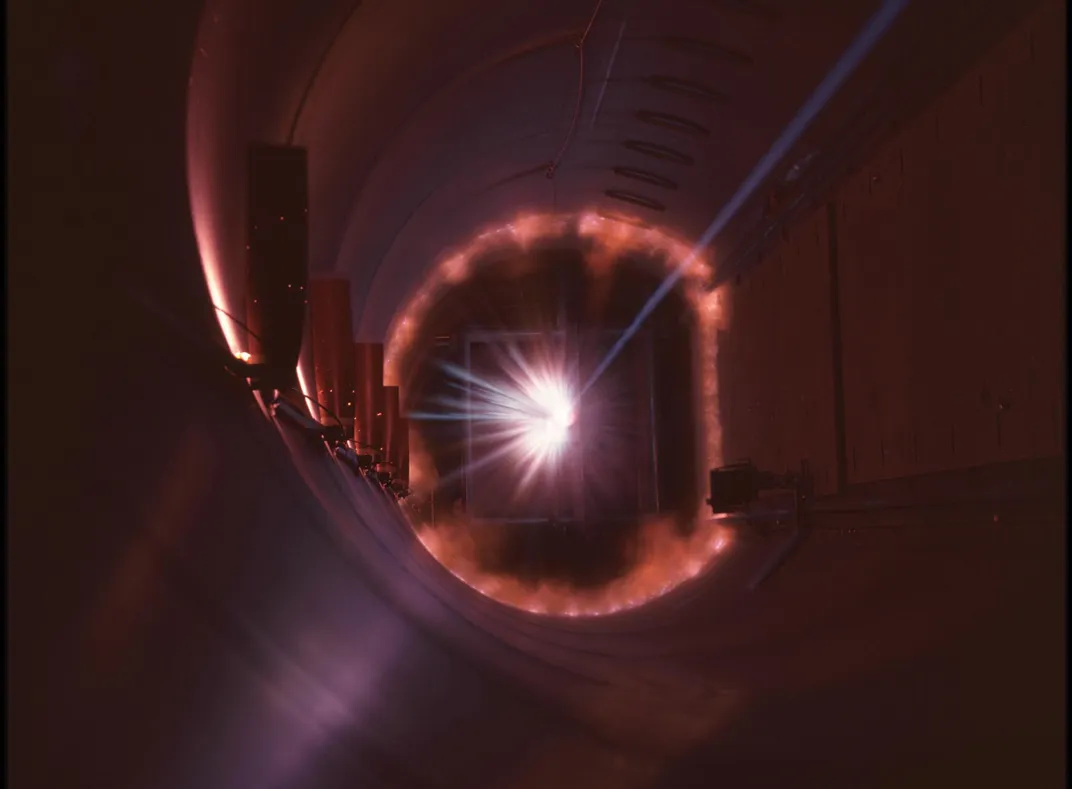
Liou’s predictions gained credibility in 2009 when Iridium 33, an active, privately owned U.S. communications satellite, collided with an inactive Russian military satellite, Kosmos-2251, at a relative speed of 26,000 mph 490 miles over Siberia. Between them, the two spacecraft—Kosmos weighing a bit over 2,000 pounds and Iridium 1,200 pounds—produced more than 2,000 pieces of softball-size space junk. Last year, more than 1,500 of those pieces were still in orbit. This was a textbook illustration of the Kessler Syndrome: a collision between two large objects traveling in different directions.
Two years after that dramatic smashup, in an article in the journal Advances in Space Research, Liou listed the “top 500” targets trapped in low Earth orbit’s most heavily trafficked polar routes. They ranged from spent rocket bodies to weather satellites and other spacecraft with masses ranging from a few hundred pounds to nearly 10 tons.
Since the Iridium-Kosmos collision, Liou says there have been “a number of proposals” for removing these large pieces of space debris. “But we have yet to identify an option that is technologically and economically feasible.”
ESA hopes to change at least part of that assessment. European reaction to the Ariane explosion and the subsequent damage to Cerise led to the establishment of an ESA debris office in 2006. Six years later, after the Chinese ASAT test and the Iridium-Kosmos crash added urgency to the space junk threat, ESA began looking into active debris removal.
“We have polluted space, and we need to take down big objects from the most populated orbits,” says ESA physicist Luisa Innocenti, manager of the Clean Space initiative. Most Earth observation satellites are clustered in polar orbits, at altitudes between 500 and 650 miles above Earth, from which vantage point they can view the whole planet as it rotates. As early as the 1970s, these preferred lanes were already filling with space junk, and today ESA estimates that 80 percent of all debris is clustered in what e.deorbit manager Robin Biesbroek describes as “the busiest area of space.” The target spacecraft for his mission—a 15-year-old Earth observation satellite called Envisat—is in just such a polar orbit 480 miles above Earth.
Once e.deorbit has identified the trash to be removed, how will it remove it? Over the years, scientists and engineers have proposed all kinds of technologies for collecting space junk. These include tethers that could fling the debris into higher or lower orbits, a blanket of expanding foam to engulf a derelict spacecraft like a giant catcher’s mitt, and land-based lasers that would aim beams to alter a spacecraft’s trajectory.
Recently the Singapore-based firm Astroscale proposed a “chaser” spacecraft that would glue itself to a piece of debris and fly it to a fiery death in the upper atmosphere. The Japanese space agency JAXA is developing a tether-based de-orbiter called KITE (Kounotori Integrated Tether Experiment). The spacecraft attaches an aluminum-stainless steel cable to a piece of debris and uses electricity generated as the miles-long tether passes through Earth’s magnetic field to slow the object and drop it into Earth’s atmosphere. The Japanese project suffered a setback earlier this year when the tether failed to deploy during its first orbital test.
ESA reviewed most of these and other proposed techniques and dismissed many as too technologically challenging, too expensive, or too politically sensitive. In the end, the Clean Space project decided to look at four options. For capture and deorbit, should engineers use a harpoon, a net, or a robotic arm? Or would it be more practical simply to lift the derelict into a safe “graveyard” orbit?
ESA awarded design contracts to several consortia to examine the concepts closely. Engineers evaluated the results at the end of 2014, and immediately ruled out graveyard re-orbiting. “We were not cleaning up space—we were just moving the debris to a higher location,” Biesbroek says. “We never liked the option, but it turned out that it’s no cheaper than de-orbiting because we need more propellant to move it up than to move it down.”
Also missing the cut was the harpoon, which Biesbroek says “combined the worst features” of the net and the robotic arm. Like the arm, the harpoon would require that the chaser spacecraft make a close—and dangerous—approach to the tumbling target. But like the net, movement and steering would be difficult, because the harpoon would not have as firm a grip on the target as the robotic arm would.
At this point, research on both the net and the robotic arm continues, but Innocenti says Clean Space managers have decided that the arm is the leading option. “Both have problems,” she says. Approach with the net is easy, and so is capture, but closing the net is something of a challenge. The robotic arm, by contrast, offers “control that is total and absolute,” according to Innocenti. Getting there, however, will require the chaser to operate autonomously for about 20 minutes at close quarters until it can grab a launch adapter ring at the stern of the target. Although automated docking between objects in space has been commonplace for years, the participating spacecraft have always been designed for rendezvous and docking. Grabbing Envisat will be like getting in synch with a bucking horse.
In the end, Innocenti says, the deciding factor was the possibility that robotic arm technology—already integral to the International Space Station—might have other applications, such as in-orbit servicing of the kind that NASA’s Restore-L envisions.
ESA’s e.deorbit project will require its own dedicated launch of a chaser spacecraft with a mass of more than 3,500 pounds—more than half of which will be propellant. The actual deorbiting will be a complicated process expected to take a few days, hence the large amount of fuel. The chaser will first need to stabilize Envisat, then slow it from 17,500 mph to its initial reentry speed of 16,000 mph. These maneuvers will end with a controlled reentry and ocean disposal.
The $400 million price for e.deorbit will come down on later flights, but with Liou’s “top 500” massive pieces of space junk stuck in low Earth orbit, cleaning up space still promises to be long, tedious, and expensive. Biesbroek envisions space tow trucks: small spacecraft—robotic or crewed—skittering around in orbit, snaring tumbling behemoths, and sending them down to perdition. He would like to see these spacecraft eventually use rechargeable electric motors that would reduce the fuel loads.
Kessler and Liou recommend that spacefaring nations take the long view: “If you move five key objects per year for 100 years, those 500 are sufficient to stabilize the low Earth orbit environment,” Kessler says. “If you have 70 launches per year, just add five more. Think of it as a tax.”
And ESA’s Bastida hopes that national space agencies will eventually get smarter about which pieces of junk pose the most risk: “It would be great if we knew which object was going to collide,” he says. “You don’t want to remove 10 objects, and the 11th is the one that collides.”
For now, number one on the cleanup list is Envisat. Launched in 2002, the satellite died in 2012 after returning data for twice as long as expected. Since then it has been racing through space in a stable orbit, though it’s tumbling. The eight-ton Envisat, says Biesbroek, is a “very large” object: eight feet wide, eight feet tall, and 33 feet long. Its solar panels have a wingspan of roughly 85 feet. If it’s struck, those eight tons will make a very large cloud of debris.
Correction note: An earlier version of this story gave an incorrect altitude for the orbit of GPS satellites. The error has been corrected.
